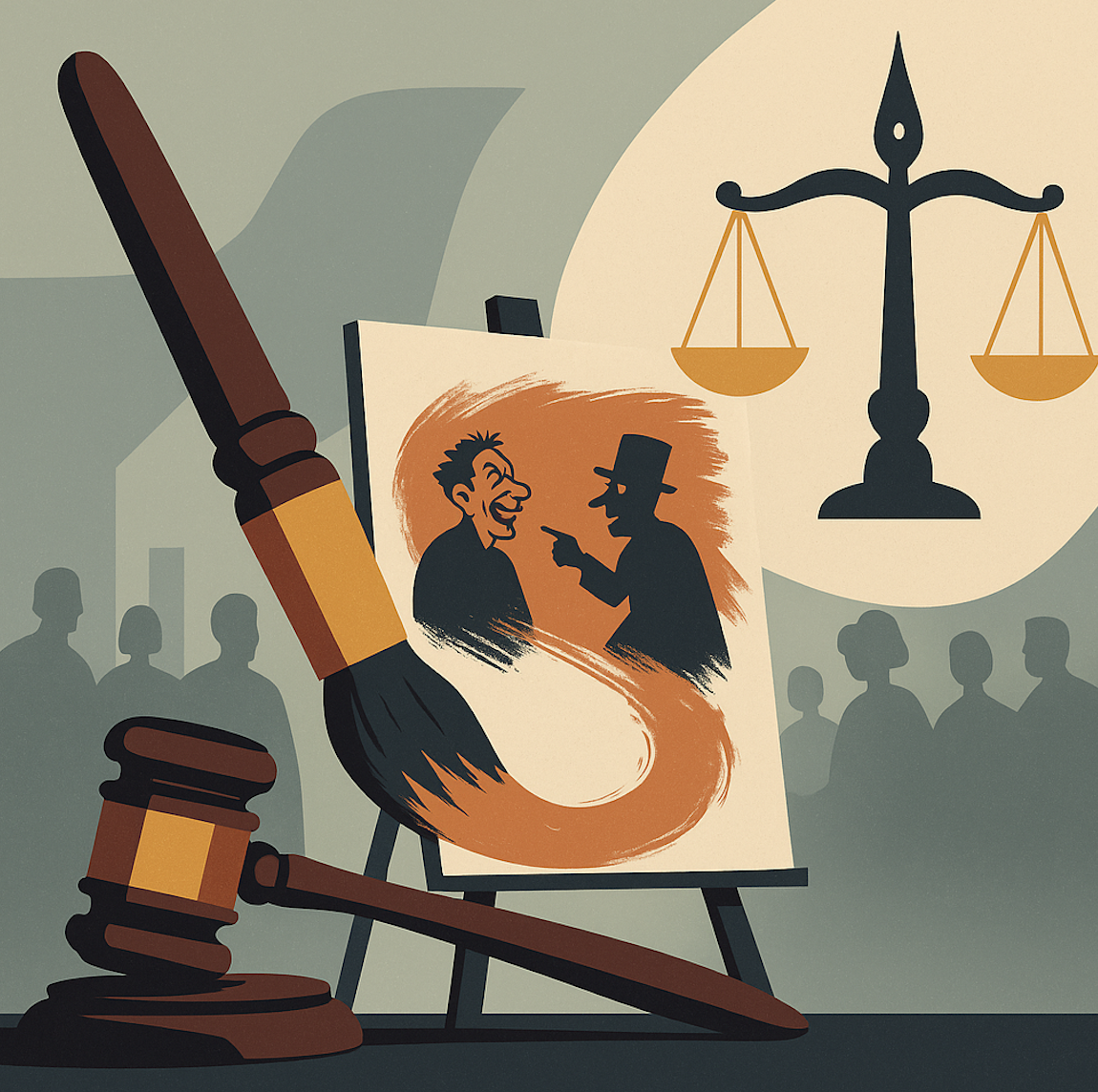Introduction
The interpretation of religious freedom and anti-discrimination norms in the workplace has become a point of contention across European legal systems. The jurisprudence of the Court of Justice of the European Union (CJEU) on this matter—particularly in cases involving the Islamic headscarf—offers a lens through which to understand the tensions between employer autonomy, customer perception, and individual rights. Three key judgments illustrate the trajectory of the Court’s reasoning: G4S Secure Solutions (C-157/15), Bougnaoui (C-188/15), and the joined cases IX v WABE eV and Müller Handels GmbH v MJ (C-804/18 and C-341/19).
This blog post presents a detailed doctrinal analysis of these judgments. It argues that while the Court has gradually moved towards a more balanced proportionality test, certain inconsistencies and conceptual problems persist—particularly with regard to the justification of neutrality as a “legitimate aim,” the requirement of necessity, and the interpretation of discrimination under Directive 2000/78/EC.
I. G4S Secure Solutions and Bougnaoui: The Foundations of the CJEU’s Reasoning
The G4S Secure Solutions and Bougnaoui judgments, both delivered in March 2017, marked the Court’s first attempts to articulate the boundaries of religious freedom and non-discrimination in employment under EU law. Both cases concerned Muslim women who were dismissed after insisting on wearing the Islamic headscarf at work. Yet, the legal bases and lines of reasoning differed in crucial ways.
A. G4S Secure Solutions (C-157/15)
In G4S, Ms. Achbita was dismissed by her employer after expressing the intention to wear a headscarf at work. The company had an internal policy—formalized shortly before her dismissal—prohibiting all employees from wearing visible signs of political, philosophical, or religious belief. The Belgian Court of Cassation asked the CJEU whether such a policy constituted direct discrimination under Article 2(2)(a) of Directive 2000/78/EC.
The CJEU distinguished between direct and indirect discrimination. Direct discrimination, defined under Article 2(2)(a), involves less favourable treatment “on the grounds” of religion. By contrast, indirect discrimination under Article 2(2)(b) may arise where a seemingly neutral rule disadvantages persons of a particular religion, unless justified by a legitimate aim and means that are appropriate and necessary.
The Court held that G4S’s policy, being of general application, did not constitute direct discrimination. It did not target Ms. Achbita’s religion specifically but applied to all forms of belief expression. However, the Court acknowledged the possibility of indirect discrimination and offered guidance on proportionality.
Importantly, the Court referred to Article 16 of the Charter of Fundamental Rights of the European Union, affirming the employer’s freedom to conduct a business. A neutrality policy might be legitimate—particularly in roles involving visual contact with clients—if applied consistently and with a genuine objective. Nonetheless, the national court was asked to assess whether the policy met the proportionality test, including whether alternative, less restrictive means were available (e.g., reassigning the employee).
While the case ostensibly focused on direct discrimination, the CJEU took the liberty of assessing the broader implications under Article 2(2)(b) and encouraged the referring court to evaluate whether G4S’s neutrality policy had an indirectly discriminatory effect and whether it was justified.
B. Bougnaoui (C-188/15)
In contrast, Bougnaoui involved a more direct link between customer preferences and the employee’s dismissal. Ms. Bougnaoui, a design engineer employed by Micropole, wore a headscarf from the beginning of her employment. However, after a client expressed discomfort, she was told not to wear it during client visits. When she refused, she was dismissed.
The French Cour de Cassation referred a question concerning Article 4(1) of Directive 2000/78/EC, which allows for differences in treatment where a characteristic constitutes a “genuine and determining occupational requirement.” The key question was whether a customer’s objection to being served by a headscarf-wearing employee could satisfy this threshold.
The CJEU held that it could not. A client’s subjective preference does not amount to an occupational requirement within the meaning of the Directive. To justify differential treatment, the requirement must be objectively dictated by the nature of the job or the context in which it is performed—not merely by third-party sensitivities.
While the employer framed neutrality as a business necessity, the Court emphasized that such justifications must meet strict standards: the occupational requirement must be genuine, legitimate, and proportionate. Bougnaoui’s dismissal, based solely on a customer complaint, failed to meet this bar.
II. Comparing G4S and Bougnaoui: Diverging Paths, Similar Facts
At first glance, the G4S and Bougnaoui cases appear strikingly similar: both involve Muslim women dismissed for refusing to remove their headscarves, both raise questions about religious neutrality in the workplace, and both fall under the scope of Directive 2000/78/EC. Yet the legal reasoning and outcomes reflect diverging approaches—raising questions about internal consistency and the conceptual foundations of the Court’s framework.
One key reason for the divergence lies in the different legal provisions invoked. In G4S, the referring court confined its question to direct discrimination under Article 2(2)(a). This allowed the CJEU to rule narrowly, holding that a general internal rule prohibiting visible religious signs—if applied consistently—does not constitute direct discrimination. While the Court offered guidance on Article 2(2)(b), it stopped short of a definitive ruling on whether the policy resulted in indirect discrimination, leaving the final assessment to the national court.
In Bougnaoui, by contrast, the question referred concerned Article 4(1), which permits differential treatment only where a religious characteristic constitutes a genuine and determining occupational requirement. Here, the CJEU adopted a stricter standard, holding that mere customer discomfort does not meet the threshold. Neutrality may be a legitimate aim, but it cannot override fundamental rights unless rooted in the essential nature of the job.
This raises a number of normative and doctrinal concerns:
-
Timing and Legal Effect of Internal Rules: In G4S, the neutrality rule was introduced only shortly before the employee’s dismissal. The Court nonetheless treated it as a general, pre-existing policy. But does the ex post formalization of a previously unwritten custom suffice to render it lawful? Conversely, in Bougnaoui, the employer had no internal rule at all—relying solely on client reaction. Should this difference in internal policy render the latter more vulnerable to challenge? And if so, is this discrepancy grounded in legal principle or mere formality?
-
Neutrality as a Legitimate Aim: Both cases recognize that neutrality may be a legitimate business objective. But G4S accepts this aim almost axiomatically, while Bougnaoui interrogates whether neutrality is truly necessary in light of the job’s nature. This discrepancy suggests an inconsistency in how “necessity” is interpreted. If neutrality is inherently legitimate in G4S, why is it insufficient in Bougnaoui?
-
Burden of Justification: The Court’s reasoning in G4S arguably places a heavier burden on employees, requiring them to adapt to general policies without necessarily questioning their proportionality. Bougnaoui flips this, scrutinizing the employer’s rationale more carefully. Yet neither case fully considers whether the employees’ refusal to remove the headscarf was the only factor contributing to their dismissal—or whether alternative accommodations could have been made.
Perhaps most importantly, both rulings neglect to assess the actual impact of headscarves on workplace neutrality. In neither case was there evidence that the employees behaved in a biased or proselytizing manner. Nor was there any indication that customers were denied services or treated differently. The assumption that visibility of religious belief undermines neutrality appears untested and, arguably, based on cultural presumptions rather than empirical analysis.
Moreover, by focusing primarily on the employer’s right to conduct a business, the Court risks sidelining other fundamental rights—particularly the right to freedom of religion under Article 10 of the Charter and Article 9 of the ECHR. The analysis remains largely employer-centric, with only cursory attention paid to the intensity of the interference with religious identity.
III. The 2021 Judgments: IX v WABE eV and Müller Handels GmbH v MJ
In July 2021, the CJEU issued its most comprehensive ruling to date on religious expression in the workplace by consolidating two German references under the preliminary ruling procedure: IX v WABE eV (C-804/18) and Müller Handels GmbH v MJ (C-341/19). The cases provided an opportunity for the Court to revisit its earlier approach and to offer a more structured framework for assessing indirect discrimination, the scope of neutrality policies, and the balance of fundamental rights in diverse employment contexts.
A. IX v WABE eV: Neutrality and Childcare Contexts
In WABE, the applicant, a Muslim woman, had been working at a childcare center operated by WABE since 2014. After returning from parental leave in 2018, she resumed wearing a headscarf—only to be suspended and reprimanded for violating a newly adopted internal policy banning all visible political, philosophical, and religious symbols in the presence of children and parents.
WABE justified the policy by invoking principles of neutrality, educational inclusion, and respect for diversity. The neutrality rule had been formulated in alignment with recommendations from the city of Hamburg, which emphasized the importance of exposing children to various religious traditions while maintaining ideological impartiality.
The policy explicitly forbade employees from (i) making political or religious statements, (ii) wearing visible symbols such as Christian crosses, Islamic headscarves, or Jewish kippahs, and (iii) performing faith-related rituals in the presence of children. It was, however, limited to staff interacting directly with children and parents—excluding administrative employees.
When the applicant challenged the policy, she claimed that it amounted to both religious and gender-based discrimination. She argued that neutrality policies disproportionately affected Muslim women and that the G4S Secure Solutionsprecedent, which had upheld general neutrality rules, did not reflect the higher protection of religious freedom under the German Basic Law.
WABE, in response, contended that its policy was lawful under EU law—specifically in line with the conditions laid out in G4S. The rule was general, applied systematically, and limited to roles involving client contact. It argued that the employer’s freedom to conduct a business, enshrined in Article 16 of the Charter, included the right to enforce neutrality in sensitive contexts like education.
The German court referred questions to the CJEU concerning whether such a policy constituted direct or indirect discrimination under Articles 2(2)(a) and (b) of Directive 2000/78, and whether it could be justified by legitimate business interests, such as neutrality.
B. Müller Handels GmbH v MJ: “Conspicuous Symbols” and Proportionality
In Müller, the applicant, MJ, had worked for the company since 2002 and began wearing a headscarf in 2014. She was initially reassigned to a non-customer-facing position but was eventually sent home for refusing to remove the headscarf. In 2016, Müller formally adopted an internal rule banning all “large and conspicuous” political, philosophical, or religious symbols.
MJ challenged the policy in national courts, arguing that it violated the principle of proportionality and her religious freedom. She claimed that the employer’s invocation of neutrality did not satisfy the test of necessity, especially in the absence of concrete disruptions or complaints.
The referring court asked the CJEU whether a ban limited only to “large and conspicuous” symbols—rather than all visible signs—could constitute direct or indirect discrimination. It also questioned whether the employer’s aim of avoiding social conflict qualified as a legitimate justification and whether the restriction respected the proportionality principle under Article 10 (freedom of religion) and Article 16 (freedom to conduct a business) of the Charter.
C. The CJEU’s Combined Reasoning
In its joined ruling, the Court reiterated its previous stance: a general, undifferentiated prohibition on visible religious, political, or philosophical signs in the workplace does not amount to direct discrimination under Article 2(2)(a) of Directive 2000/78—provided that it is applied in a consistent and systematic manner to all employees, regardless of specific beliefs.
However, the Court emphasized that such a rule may still constitute indirect discrimination under Article 2(2)(b) if it places persons of a particular religion—such as Muslim women wearing headscarves—at a particular disadvantage. In such cases, the employer must justify the policy by showing:
-
A legitimate aim, such as maintaining neutrality in sensitive roles or avoiding social conflict;
-
Suitability, meaning the policy must be appropriate to achieve the aim;
-
Necessity, meaning there must be no less restrictive alternatives;
-
Proportionality, meaning the impact on individual rights must be carefully weighed against the employer’s interest.
Importantly, the Court warned that a policy targeting only “conspicuous” or “large” religious symbols may in fact result in direct discrimination—especially if it disproportionately affects adherents of religions that require such visible signs (e.g., Muslim women). In such cases, the policy could be inherently linked to religion and fail to meet the neutrality threshold.
The Court also accepted that Member States may adopt more protective standards under Article 8(1) of the Directive, provided that they remain compatible with EU law. Specifically, the German constitutional requirement that an employer must prove a concrete risk to neutrality—not just a legitimate aim—was found to be permissible and consistent with the Directive’s minimum harmonization framework.
Finally, the Court recognized that policies disproportionately affecting headscarf-wearing women may also amount to intersectional discrimination—involving both religion and gender. This expanded the interpretive scope of the Directive and brought EU law closer in line with ECHR jurisprudence.
IV. Normative Reflections: Between Neutrality and Exclusion
The CJEU’s trajectory from G4S through WABE and Müller reveals both progression and persistent blind spots. While the Court has moved toward a more robust proportionality test and recognized the need for genuine justifications, the framework it provides continues to rest on certain untested assumptions that threaten to undermine the very rights the Directive seeks to protect.
A. The Flawed Proportionality Inquiry
In G4S, the Court accepts at face value that neutrality constitutes a legitimate aim under Article 16 of the Charter, particularly in customer-facing roles. Yet it fails to examine whether such neutrality is actually necessary or objectively linked to the job’s nature. It is never asked, for example, whether Ms. Achbita’s headscarf interfered with her performance or compromised service delivery. Nor is there any indication that clients received less favorable treatment. The employer’s rationale is assumed, rather than demonstrated.
This omission leaves a gap in the necessity analysis. If neutrality is to override fundamental rights, it must be shown not only to pursue a legitimate aim but also to meet a pressing social need. In later judgments (WABE and Müller), the Court rightly tightens this inquiry, insisting that the employer prove a genuine need and that no less restrictive alternative exists. Still, even in these rulings, the evidentiary burden on the employer remains relatively light—often relying on hypothetical risks of conflict or generic references to client expectations.
B. The Problem with Customer Discomfort
One of the most dangerous precedents set in this line of cases is the implicit deference to customer preference. In Bougnaoui, the Court held that a client’s unease cannot justify limiting religious expression. However, in practice, the economic logic of the employer’s fear of losing clients appears to remain a valid underlying consideration. This risks normalizing discrimination by outsourcing employer neutrality to the subjective biases of consumers.
If a client’s discomfort with a headscarf is enough to trigger a neutrality policy, then what prevents similar arguments about race, accent, or national origin? The legitimacy of employer aims must be scrutinized not only for formal consistency, but also for their reliance on social prejudices.
C. Religious Freedom and the Right to Work
Perhaps the most overlooked aspect of the CJEU’s case law is the indivisibility of religious freedom and access to employment. For many Muslim women, wearing a headscarf is not a symbolic or occasional act—it is a central, continuous aspect of religious practice. A policy that prohibits visible religious symbols in the workplace does not merely limit expression—it excludes such individuals from entire sectors of the labour market.
This is not a mere inconvenience. It constitutes a structural barrier to the right to work under Article 15 of the Charter and risks violating the very essence of religious identity protected under Article 10. The suggestion in G4S and WABE that affected employees could be reassigned to “non-customer-facing roles” further entrenches occupational segregation and denies professional development.
D. Intersectionality and Structural Disadvantage
The Court’s acknowledgment in WABE that headscarf bans may disproportionately affect Muslim women is a welcome shift. Yet the reasoning still treats religion and gender as abstract categories, rather than recognizing the compounded forms of marginalization they produce. Discrimination is not merely the result of formal rules—it is produced by the unequal effects of facially neutral policies that interact with social hierarchies.
As Europe becomes more diverse, courts must reckon with this structural inequality. The refusal to see religious visibility as compatible with professional life reinforces the very stereotypes that discrimination law seeks to undo. The invocation of “neutrality” as a business aesthetic can easily become a coded exclusion of difference.
E. National Standards and the Limits of Harmonization
Finally, the Court’s recognition that Member States may adopt more protective standards under Article 8(1) of the Directive is critical. The reference to the German Basic Law and its higher threshold for justifying restrictions on religious freedom—requiring not only a legitimate aim but also proof of an actual threat—is a powerful reminder of the diversity of constitutional traditions in the EU.
This acknowledgment is more than a doctrinal footnote. It opens the door for national courts to demand more from employers: not just generic appeals to neutrality, but concrete evidence of necessity and proportionality. It also suggests that minimum harmonization under Directive 2000/78 should not be interpreted as a ceiling—but a floor on which more substantive protections can be built.
Conclusion: A Need for Reorientation
The jurisprudence of the CJEU on religious discrimination in the workplace reflects a legal system still grappling with pluralism. The shift from G4S to WABE and Müller marks progress: from formal neutrality to a more substantive balancing of rights. But key questions remain: Why is neutrality assumed to be incompatible with visible religiosity? Why are policies that exclude religious minorities justified by vague fears of discomfort or disruption? And why is the burden placed on workers to adapt, rather than on employers to accommodate?
As European societies grow more religiously and culturally diverse, the law must reflect that transformation. Anti-discrimination norms should not be instruments of assimilation but tools of inclusion. If neutrality is to mean anything in a democratic society, it must begin by recognizing the legitimacy of difference—not suppressing it.





